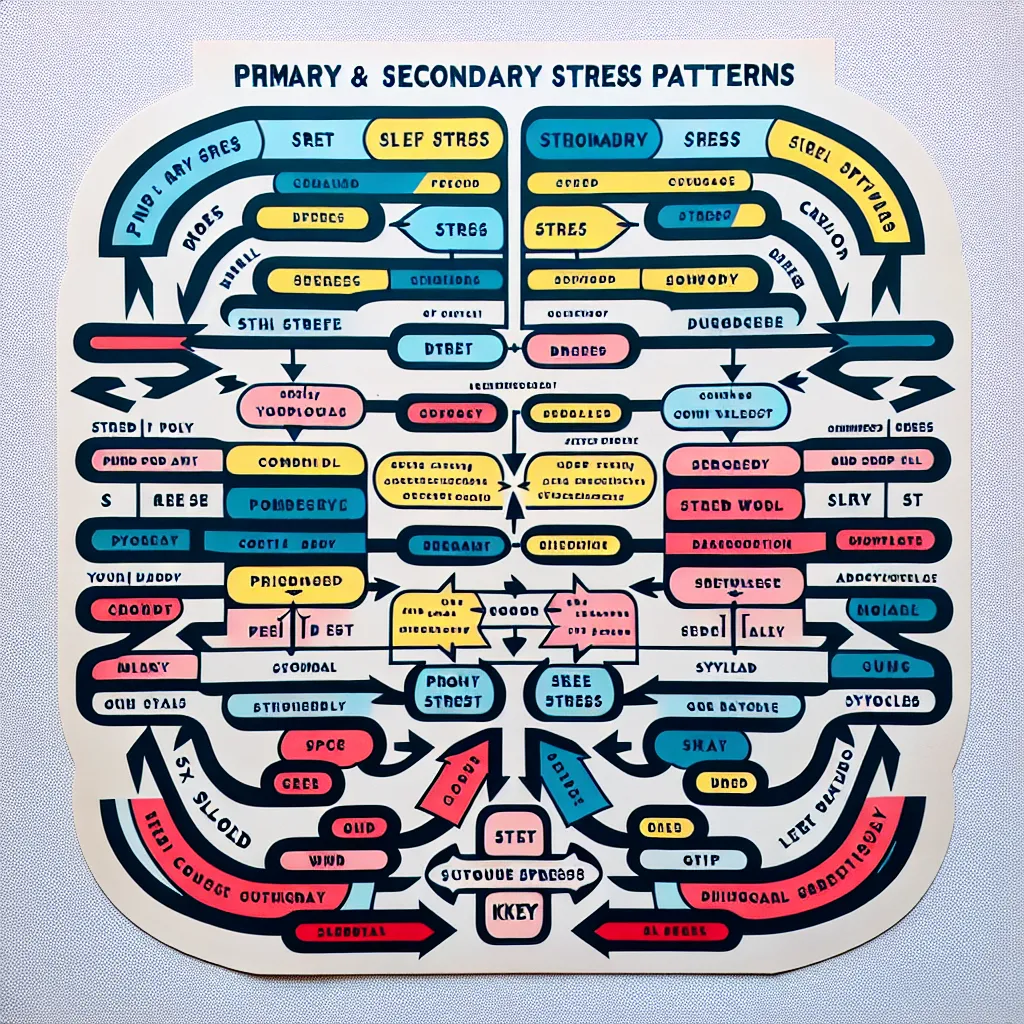English stress patterns play a crucial role in pronunciation and overall fluency. Mastering these patterns can significantly enhance your communication skills and help you sound more natural when speaking English. In this comprehensive guide, we’ll explore various strategies to help you improve your understanding and application of English stress patterns.
Understanding English Stress Patterns
What Are Stress Patterns?
Stress patterns in English refer to the emphasis placed on certain syllables or words within a sentence. These patterns are essential for conveying meaning and maintaining the rhythm of spoken English. Proper stress can differentiate between similar-sounding words and clarify the intended message.
 English Stress Patterns Diagram
English Stress Patterns Diagram
Why Are Stress Patterns Important?
Mastering English stress patterns is crucial for several reasons:
- Improved comprehension: Proper stress helps listeners understand your message more easily.
- Enhanced fluency: Correct stress patterns contribute to a more natural-sounding speech.
- Reduced miscommunication: Proper stress can prevent misunderstandings caused by mispronunciation.
- Increased confidence: Knowing how to stress words correctly can boost your confidence in speaking English.
Strategies for Mastering English Stress Patterns
1. Learn the Rules of Word Stress
Understanding the basic rules of word stress in English is the foundation for mastering stress patterns. Here are some key rules to remember:
- Two-syllable nouns and adjectives typically stress the first syllable (e.g., TA-ble, HAP-py).
- Two-syllable verbs often stress the second syllable (e.g., de-CIDE, be-GIN).
- Words ending in -tion, -sion, -cian usually stress the syllable before the suffix (e.g., ed-u-CA-tion, mu-SI-cian).
- Compound nouns generally stress the first word (e.g., TOOTH-brush, BOOK-shelf).
Practice these rules with word lists and try to identify the stress patterns in new words you encounter.
2. Use Stress-Marking Techniques
Develop a system for marking stress in written words to help you visualize and remember the correct patterns. Some common techniques include:
- Capitalizing stressed syllables: proNUNciation
- Using accent marks: pronùnciation
- Underlining stressed syllables: pronunciation
Choose a method that works best for you and use it consistently when learning new vocabulary or practicing pronunciation.
3. Listen and Imitate Native Speakers
One of the most effective ways to improve your stress patterns is by listening to and imitating native English speakers. Here’s how you can practice this:
- Watch English movies, TV shows, or YouTube videos with native speakers.
- Listen to podcasts or audiobooks in English.
- Pay attention to the rise and fall of their voices and try to replicate the patterns.
- Record yourself speaking and compare it to native speakers’ pronunciation.
4. Practice with Stress-Shifting Words
Some English words change their stress pattern depending on their function in a sentence. Practice with these words to improve your flexibility in applying stress:
- CON-duct (noun) vs. con-DUCT (verb)
- PRO-duce (noun) vs. pro-DUCE (verb)
- RE-cord (noun) vs. re-CORD (verb)
Create sentences using these words in different contexts to reinforce the correct stress patterns.
5. Focus on Sentence Stress
In addition to word stress, sentence stress is crucial for conveying meaning in English. Here are some tips for mastering sentence stress:
- Stress content words (nouns, main verbs, adjectives, adverbs) more than function words (articles, prepositions, pronouns).
- Practice emphasizing different words in a sentence to change its meaning:
- I didn’t say he stole the money. (Someone else said it)
- I didn’t say he stole the money. (I definitely didn’t say it)
- I didn’t say he stole the money. (But I might have implied it)
6. Use Rhythm and Music
Incorporating rhythm and music into your learning can help you internalize English stress patterns:
- Practice with jazz chants or nursery rhymes that emphasize rhythm and stress.
- Create your own rhythmic patterns for words or phrases you find challenging.
- Use music to familiarize yourself with the natural rhythm of English speech.
 English Rhythm Practice
English Rhythm Practice
7. Utilize Technology and Apps
Take advantage of technology to enhance your learning:
- Use pronunciation apps that provide visual feedback on your stress patterns.
- Try speech-to-text software to see how accurately your pronunciation is recognized.
- Use online dictionaries with audio pronunciation features to check individual words.
For more tips on using technology to improve your pronunciation, check out our article on how to improve pronunciation using feedback.
Common Mistakes in English Stress Patterns
Be aware of these common mistakes to avoid them in your own speech:
- Overstressing function words: Remember to focus on content words for sentence stress.
- Misplacing stress in multisyllabic words: Always check the correct stress pattern for longer words.
- Ignoring stress shifts in words with multiple functions: Pay attention to how stress changes based on the word’s role in a sentence.
- Applying native language stress patterns to English: Be mindful of the differences between English and your native language’s stress rules.
Phonemic Chart and Commonly Mispronounced Words
Familiarize yourself with the English Phonemic Chart to understand the sounds and stress patterns of English. Here are ten commonly mispronounced words related to stress patterns, along with their correct pronunciations:
- Photograph (FOE-tuh-graf)
- Photography (fuh-TOG-ruh-fee)
- Photographer (fuh-TOG-ruh-fer)
- Development (di-VEL-uhp-muhnt)
- Interesting (IN-ter-es-ting)
- Comfortable (KUHM-fer-tuh-buhl)
- Vegetable (VEJ-tuh-buhl)
- Pronunciation (pruh-nuhn-see-EY-shuhn)
- Advertisement (ad-VER-tis-muhnt) (British) / (AD-ver-tayz-muhnt) (American)
- Hierarchy (HAI-uh-rahr-kee)
Practice these words regularly, paying close attention to their stress patterns.
Conclusion
Mastering English stress patterns is a journey that requires patience, practice, and persistence. By incorporating these strategies into your language learning routine, you’ll gradually improve your pronunciation and overall fluency in English. Remember to be consistent in your practice and don’t be afraid to make mistakes – they’re a natural part of the learning process.
For more tips on improving your English pronunciation, check out our articles on how to master English word endings and tips for mastering the rhythm and melody of English.
Keep practicing, stay motivated, and soon you’ll notice significant improvements in your ability to use English stress patterns effectively!




